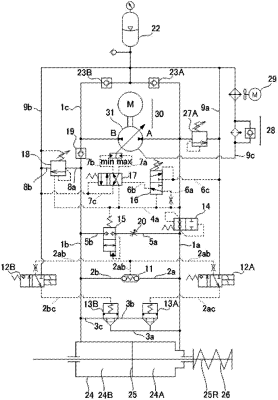| CPC F01D 17/10 (2013.01) [F01D 21/18 (2013.01); F15B 13/01 (2013.01); F15B 13/027 (2013.01); F15B 13/028 (2013.01); F15B 20/002 (2013.01); F15B 20/004 (2013.01); F05D 2220/31 (2013.01); F05D 2270/303 (2013.01)] | 15 Claims |

|
1. An electrohydrostatic actuation system comprising:
a hydraulic cylinder including:
a piston to which a valve element biased by a return spring is connected;
a first chamber; and
a second chamber;
a hydraulic pump configured to supply hydraulic fluid to the first chamber or the second chamber;
an electric motor configured to drive the hydraulic pump;
a shuttle valve configured to establish communication to a downstream side under a state in which a hydraulic pressure generated by the hydraulic pump is maintained, the hydraulic fluid having a higher pressure in pressures of the hydraulic fluid to be supplied;
a solenoid valve configured to receive the hydraulic pressure via the shuttle valve as a pilot pressure; and
a logic valve including:
a first port configured to receive the pilot pressure from the solenoid valve; and
a second port communicated to the first chamber of the hydraulic cylinder,
wherein, when the solenoid valve is brought to a de-energized state, the pilot pressure of the logic valve is released, and the logic valve causes the hydraulic fluid in the first chamber communicated to the second port to flow into the second chamber so that emergency shut-off of the valve element is achieved by the return spring.
|
|
9. An electrohydrostatic actuation system comprising:
a hydraulic cylinder including:
a piston to which a valve element biased by a return spring is connected;
a first chamber; and
a second chamber;
a hydraulic pump configured to supply hydraulic fluid to the first chamber or the second chamber, or to collect the hydraulic fluid from the first chamber or the second chamber;
an electric motor configured to drive the hydraulic pump;
a fuse valve provided in a fluid passage communicating between the hydraulic pump and the first chamber of the hydraulic cylinder; and
a logic valve,
wherein, when the electric motor loses electric power, and a flow rate of the hydraulic fluid in the fluid passage returning from the hydraulic cylinder to the hydraulic pump exceeds a predetermined value, the fuse valve blocks a flow of the hydraulic fluid in the fluid passage, and
wherein the logic valve is configured to connect a circuit so as to cause the blocked hydraulic fluid to return to the second chamber of the hydraulic cylinder so that fail-safe shut-off of the valve element is achieved to protect the hydraulic pump.
|
|
13. An electrohydrostatic actuation system comprising:
a hydraulic cylinder including:
a piston to which a valve element biased by a return spring is connected;
a first chamber; and
a second chamber;
a hydraulic pump configured to supply hydraulic fluid to the first chamber or the second chamber, or to collect the hydraulic fluid from the first chamber or the second chamber;
an electric motor configured to drive the hydraulic pump;
a sequence valve; and
a four-port, two-position pilot-operated directional control valve,
wherein, when a pressure of the hydraulic fluid discharged from the hydraulic pump becomes lower than a predetermined set value, the sequence valve reduces a pilot pressure to be applied to the four-port, two-position pilot-operated directional control valve, and the four-port, two-position pilot-operated directional control valve connects between a discharge port of the hydraulic pump and a pilot line of the hydraulic pump at which a displacement of the hydraulic pump is maximum, and
wherein, when the pressure of the hydraulic fluid discharged from the hydraulic pump exceeds the predetermined set value, the sequence valve increases the pilot pressure to be applied to the four-port, two-position pilot-operated directional control valve, and the four-port, two-position pilot-operated directional control valve connects between the discharge port of the hydraulic pump and a pilot line of the hydraulic pump at which the displacement of the hydraulic pump is minimum so that a displacement of the hydraulic pump is controlled.
|
|
15. An electrohydrostatic actuation system comprising:
a hydraulic cylinder including:
a piston to which a valve element biased by a return spring is connected;
a first chamber; and
a second chamber;
a hydraulic pump configured to supply hydraulic fluid to the first chamber or the second chamber, or to collect the hydraulic fluid from the first chamber or the second chamber;
an electric motor configured to drive the hydraulic pump;
a pilot-assisted open relief valve; and
a check valve,
wherein, in an operation of opening the valve element, the hydraulic fluid from the second chamber is blocked by the check valve, and the pilot-assisted open relief valve receives a pilot pressure by a pressure of the hydraulic fluid and is thus opened so that the hydraulic fluid from the second chamber flows through a drain line via the pilot-assisted open relief valve so as to be cooled, and
wherein, in an operation of closing the valve element, the hydraulic fluid is supplied to the second chamber via the check valve.
|